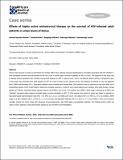Effects of Highly Active Antiretroviral Therapy on the Survival of HIV-infected Adult Patients in Urban Slums of Kenya
View/
Publication Date
1/22/2015Type
Article, Journalviews
downloads
Metadata
Show full item recordCitation
Samuel Opondo Muhula, Memiah Peter, Biadgilign Sibhatu, Ndirangu Meshack, Kyomuhangi Lennie Pan Afr Med J. 2015; 20: 63. Published online 2015 Jan 22. doi: 10.11604/pamj.2015.20.63.4865 PMCID: PMC4450049
Abstract/
Recent improvements in access to Anti-Retroviral Therapy (ART) have radically reduced hospitalizations and deaths associated with HIV infection in both developed countries and sub-Saharan Africa. Not much is known about survival of patients on ART in slums. The objective of this study was to identify factors associated with mortality among adult patients on ART in resource poor, urban, sub-Saharan African setting. A prospective open cohort study was conducted with adult patients on ART at a clinic in Kibera slums, Nairobi, Kenya. The patients’ enrollment to care was between March 2005 and November 2011. Descriptive statistics were computed and Kaplan-Meier (KM) methods used to estimate survival time while Cox's proportional hazards (CPH) model fitted to determine mortality predictors. A total of 2,011 adult patients were studied, 69% being female. Female gender (p = 0.0016), zidovudine-based regimen patients (p < 0.0001), CD4 count >351 patients (p < 0.0001), WHO stage I patients (p < 0.0001) and “Working” functional status patients recorded better survival probability on ART. In CPH analysis, the hazard of dying was higher in patients on Stavudine-based regimen(hazard ratio (HR) =1.8; 95% CI, 1.5-2.2; p < 0.0001),CD4 count <50 cells/µl (HR = 1.6; 95% CI, 1.5-1.7;p < 0.0001), WHO Stage IV at ART initiation (HR = 1.3; 95% CI, 1.1-1.6; p = 0.016) and bedridden patients (HR = 2.7; 95% CI, 1.7-4.4;p < 0.0001). There was increased mortality among the males, those with advanced Immunosuppression, late WHO stage and bedridden patients. The findings further justify the need to switch patients on Stavudine-based regimen as per the WHO recommendations.
Further Details
© Samuel Opondo Muhula et al. The Pan African Medical Journal - ISSN 1937-8688. This is an Open Access article distributed under the terms of the Creative Commons Attribution License (http://creativecommons.org/licenses/by/2.0), which permits unrestricted use, distribution, and reproduction in any medium, provided the original work is properly cited
Publisher
Pan African Medical JournalCollections
- General - GEN [367]

